Page Content
- Volcanic Edifice and Lava Field
- Magma Plumbing System
- Eruptive and Seismic Activity
- Cited References
_______________________________
1. Volcanic Edifice and Lava Field
To the East of the African Rift Valley and its active Virunga volcanoes Nyamulagira and Nyiragongo, lies the central and eastern part of the VVP, also called ‘the off-rift Virunga” (Fig. 1). The off-rift part of the VVP constitutes six large and dormant polygenetic volcanoes, and numerous small eruptive centers scattered in groups over the lava fields. Some of these off-rift volcanoes are home to groups of the endangered Mountain Gorilla species.
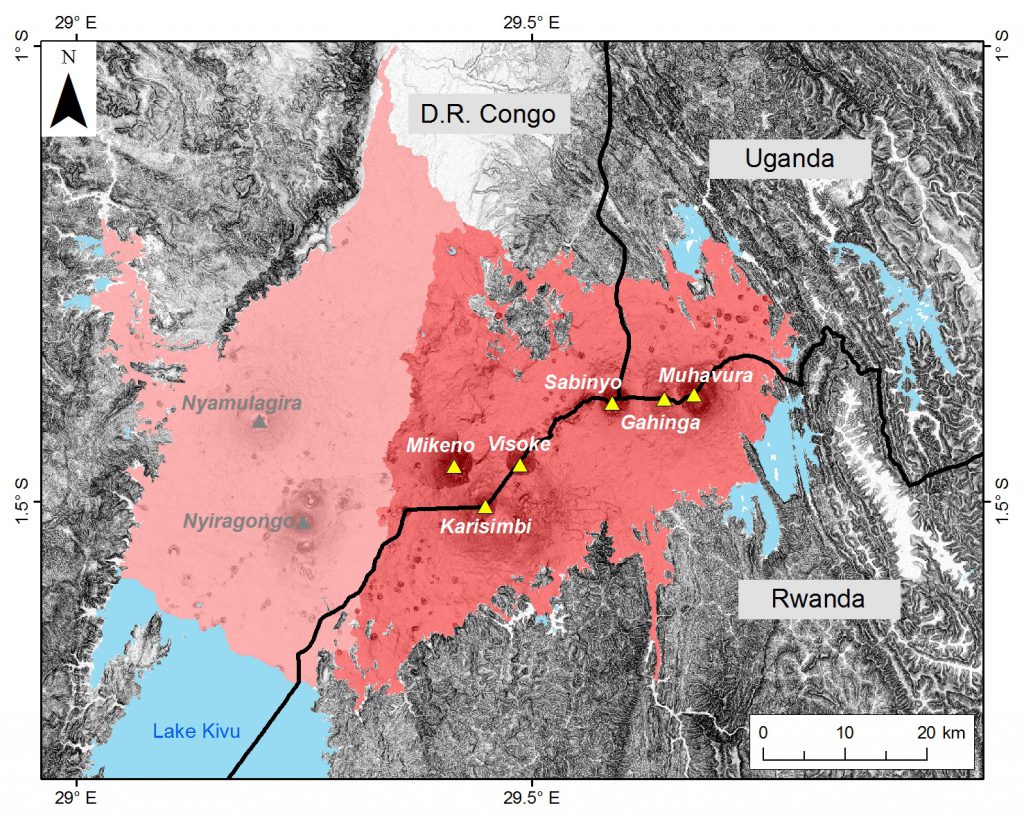
Off-rift volcanism in the VVP has received considerably less scientific attention compared to both currently active volcanoes, but the most important findings from the past have been recently summarised and completed further by Pouclet et al. (2016) and Smets et al. (2016), while Poppe et al. (in prep.) quantified the morphology of the large and small volcanoes in the frame of an overall volcanic hazard assessment.
Central Virunga
Mikeno (4437 m a.s.l.; Fig. 2) is one of the highest and most eroded off-rift volcanoes. Its western flanks are steep and cut by deep erosional valleys, and a steep and high scarp marks the major collapse of its eastern flank at an unknown moment in the past. The ‘young Mikeno’ edifice is supposedly built from younger volcanic rocks inside the collapse sector. All of this provides Mikeno with an assymetric and rough topography. Mikeno is therefore interpreted as (one of) the oldest Virunga volcanoes. Guibert et al. (1977) and Guibert (1978) studied Mikeno’s petrography and geochemistry, and provided ages of Mikeno’s volcanic rocks ranging from 4.6 to 0.2 million years.
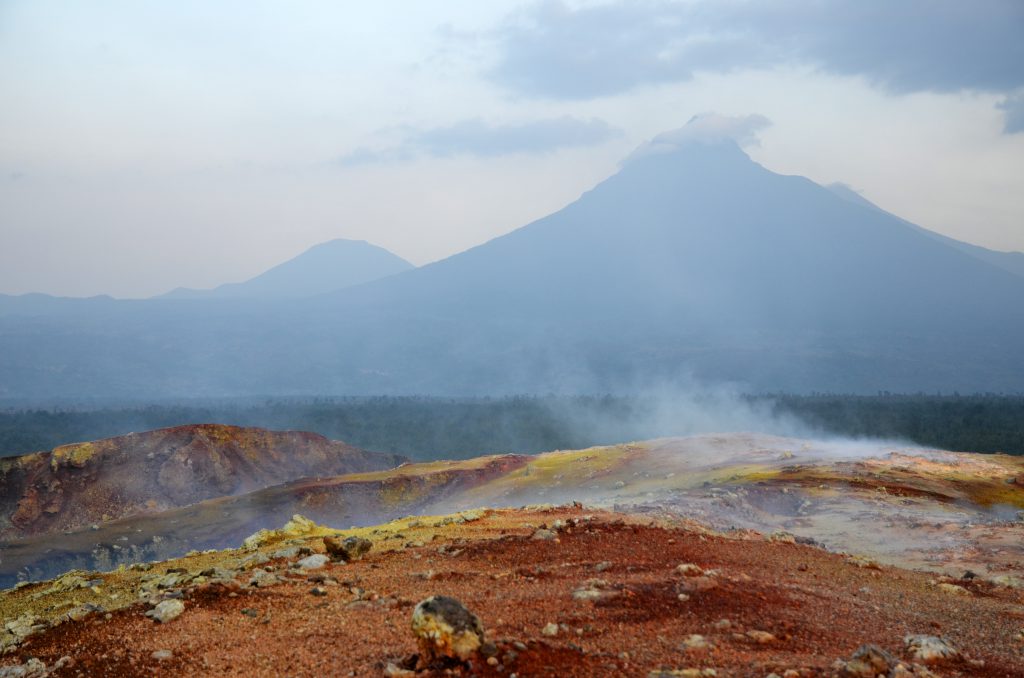
Karisimbi (4507 m a.s.l.) is the most impressive volcanic edifice of the entire Virunga range in terms of volume and dimensions. Its summit is the highest point in the region. The summit is hence occasionally occupied by limited amounts of snow during the dry season (Fig. 3). The volcano is a complex edifice built in several phases, including a broad shield volcano with a flat-topped summit area holding the pit crater named Muntango and the caldera La Branca, and the much steeper summit cone located on the northern part of this dome-like shield (De Mulder 1985). The most recent activity of Karisimbi most likely yields from thick viscous lava flows of trachytic composition on Karisimbi’s southeastern flank. The youngest of these trachyte flows was dated at a significantly recent ~10,000 years old (De Mulder & Pasteels 1986). Karisimbi thus appears dormant and should certainly not to be seen as an extinct volcano.
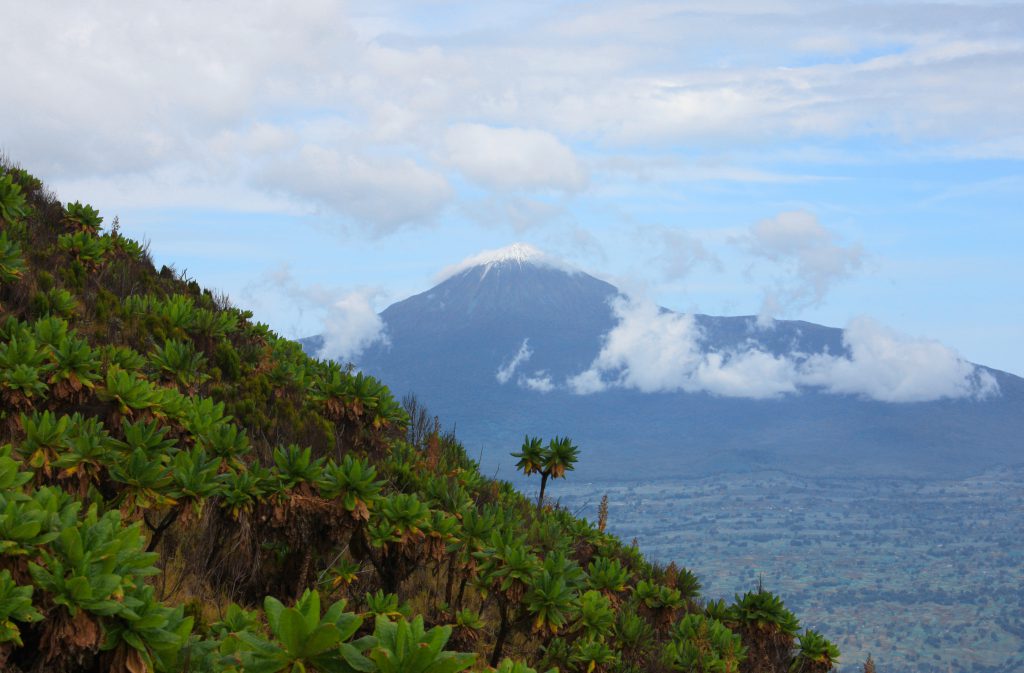
Visoke (or Bisoke, 3711 m a.s.l.) is the third Central Virunga volcano and is a steep polygenetic volcano located north-east of Karisimbi. Visoke holds a summit crater lake and erosional valleys less incised than at Mikeno. It is thus generally assumed younger than the latter. The Mugogo 1957 eruption, which occurred ~11 km north of Visoke, has mistakingly been attributed to Visoke by several authors (see Section 3). The Visoke rocks lean closest in composition to the leucite-bearing, ultra-alkaline and extremely silica-undersaturated magmatic suite that characterises Nyiragongo (Marcelot and Rançon, 1988).
Eastern Virunga
Sabinyo (3645 m a.s.l.) is the westernmost volcano in the East-VVP. Its Kinyarwanda name stands for « Teeth of the old man », an allusion to its rough profile with several peaks and deep erosional values. At the surface of Sabinyo, Bagdasaryan et al. (1973) and Rogers et al. (1998) found rocks of ages ranging between 0.264 and 0.014 million years old, but much of the edifice is covered by « boulder beds » from the extensive occurrence of lahars and debris flows due to the pervasive erosion of the surface. The knowledge of Sabinyo’s stratigraphy and constructional phases is, hence, very poorly constrained.
Gahinga (3474 m a.s.l.) lies at an elevated ridge to the East of Sabinyo. Its morphology stands in sharp contrast to Sabinyo: that of a flat-topped smooth cone with steep slopes. Gahinga is smaller in volume compared to its neighbors, and little is known about its volcanics, except for their geochemistry being similar to the K-basanite of Muhavura and the main suite of Sabinyo (Rogers et al. 1998).
Muhavura (or Muhabura, 4127 m a.s.l.; Fig. 4) is the easternmost volcano of the VVP and certainly one of the more voluminous edifices. Its steep peak holds a small crater lake. Allthough Muhavura shows steep escarpments and flank bulges as clear signs of flank instability in its topographic profile, it is not clear it collapsed in the past as Mikeno did (Poppe et al. in prep.). Rock datings at Muhavura have reported ages ranging between 0.251 and 0.020 million years (Rogers et al. 1998).
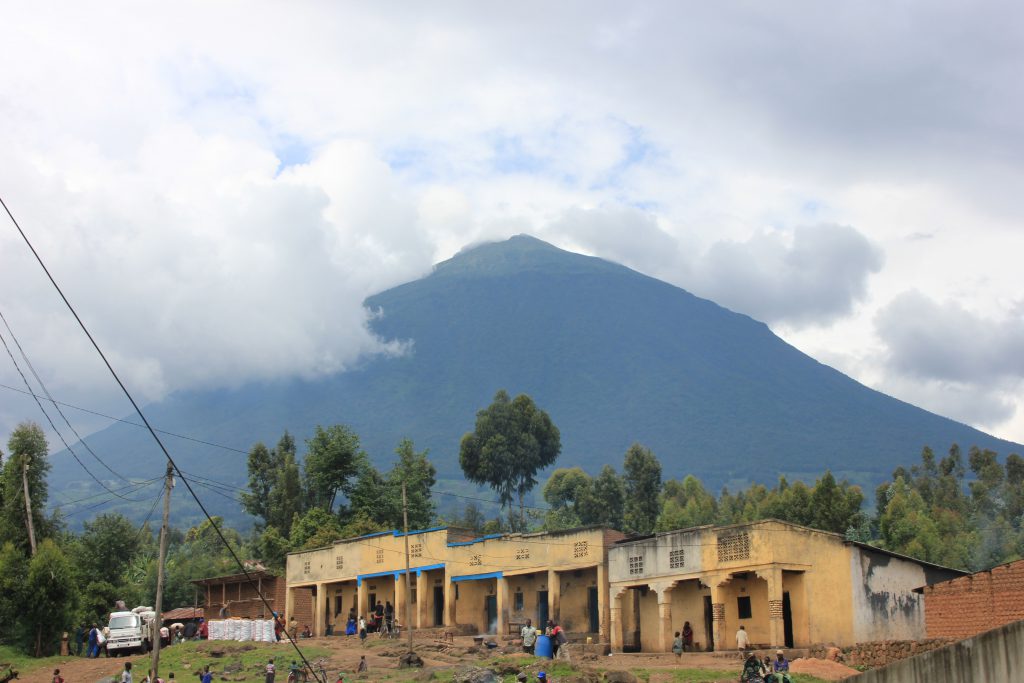
Pre-Virunga volcanism
If volcanoes of the central and eastern Virunga are considered older than Nyamulagira and Nyiragongo volcanoes, the oldest volcanism is found in the Bishusa-Tongo area, which lies on the western rift shoulder, west of the Nyamulagira lava field (Fig. 5). Here can be found residual basaltic lava flows, from which the oldest geochronological ages were retrieved between 12.6 and 8.6 million years (Bellon & Pouclet 1980; Kampunzu et al. 1998). These volcanics are interpreted to have formed before the main Virunga volcanism, and are thus named ‘Pre-Virunga volcanics’ (Pouclet et al., 2016).
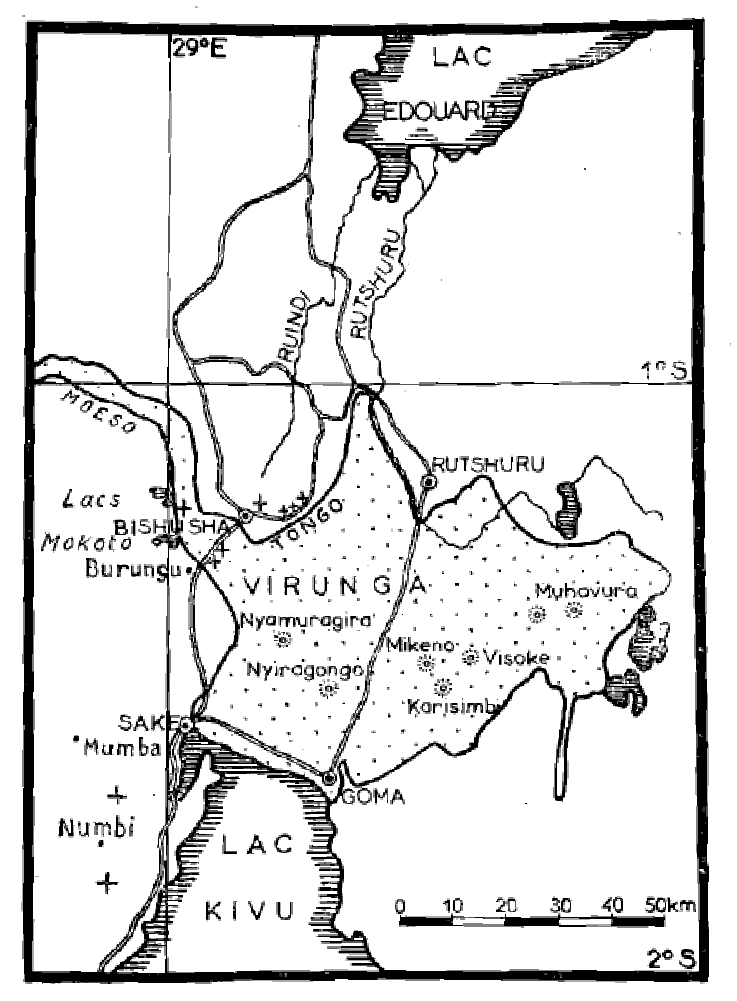
—
2. Magma Plumbing Systems
The knowledge of the volcanic plumbing systems below the off-rift Virunga branch is more limited compared to that of the Nyamulagira and Nyiragongo systems. The presence of several large edifices at least indicates the existence of crustal magmatic chambers. Geochemistry studies on Karisimbi (De Mulder, 1985; De Mulder and Pasteels, 1986), Mikeno (Guibert et al., 1975; Guibert, 1978) and Sabinyo, Gahinga and Muhavura (Rogers et al., 1998) have revealed that volcanic products of some of these volcanoes show clear signals of fractionation and crustal contamination, and magma storage in crustal and shallow magmatic reservoirs for prolonged periods of time. These volcanic products are represented by silica-rich and viscous lavas, which stand in contrast with the very silica-undersaturated magmas produced at Nyiragongo and Nyamulagira, and most of the small eruptive centers scattered over the VVP. Rogers et al. (1998) and Pouclet et al. (2016) proposed models of magma production and storage for the VVP. Condomines et al. (2015) and Barette et al. (2016) demonstrated that a suite of alkaline and silica-undersaturated volcanics exists throughout the VVP, both in and outside the rift valley, with a geochemical composition which leans most towards a primitive mantle composition which did not undergo crustal contamination nor fractionation, and thus most likely ascends directly from its source region in the upper mantle through crustal faults towards the surface.
—
3. Eruptive and seismic activity
The six off-rift Virunga volcanoes have not erupted since modern historic accounts have started, in the late 19th Century. The assumingly youngest volcanic rocks can be found in the form of trachytic lava flows on the southeastern flanks of Karisimbi volcano. A historic eruption however occurred in 1957, in the Congolese part of the off-rift Virunga, ~10 km north of Visoke. The event has been called the ‘Mugogo’ eruption, and was described by Verhaeghe (1958). This eruption has been repeatedly attributed to the plumbing system of Visoke volcano, but 21st century renewed scientific interest has opposed that interpretation, using trace element and isotopic composition of this very small-volume eruptive cone and lava flow (Condomines et al., 2015; Barette et al., 2016). As previously mentioned, these studies demonstrated the occurrence of small-volume volcanic eruptions fed by a ‘deep’ magmatic source situated in the upper parts of the mantle, from which magma ascended rapidly towards the surface without much residence time within the crust. Structural analysis has shown these eruptions dominantly occur along NE-SW oriented deep faults which are part of the inherited fault systems in the Precambrian basement rocks below the Virunga (Smets et al., 2016; Poppe et al., in prep.). Mugogo classifies as one of such small eruptive centers, and thus stands as an indicator of the dispersed ‘monogenetic’ volcanic hazard throughout the VVP. Additionally, Wood et al. (2015) measured a significant amount of volcano-seismic activity between Nyiragongo and Karisimbi, below the southwestern part of the broad Karisimbi dome. Even though the period of measurements only encompassed six months, this is an additional signal that at least the Central VVP should be approached as an active volcanic area.
In conclusion, we do not know that much on the recent eruptive activity of the central and eastern Virunga, but the off-rift Virunga should not be interpreted as an extinct volcanic field, at least until additional volcanological investigations allow refining this interpretation.
—
4. Cited references
Bagdasaryan, G.P., Gerasimovskiy, V.I., Polyakov, A.I., Gukasyan, R.K., Vernadskiy, V.I., 1973. Age of volcanic rocks in the rift zones of East Africa. Geokhimiya, 1, pp.84–90.
Barette, F., Poppe, S., Smets, B., Benbakkar, M., Kervyn, M. 2016. Spatial variation of volcanic rock geochemistry in the Virunga Volcanic Province: Statistical analysis of an integrated database. Journal of African Earth Sciences, pp.1–16. Available at: http://dx.doi.org/10.1016/j.jafrearsci.2016.09.018.
Bellon, H., Pouclet, A., 1980. Datations K-Ar de quelques laves du Rift-ouest de l’Afrique Centrale; implications sur l’évolution magmatique et structurale. Geologische Rundschau, 69(1), pp.49–62.
Condomines, M., Carpentier, M., Ongendangenda, T., 2015. Extreme radium deficit in the 1957 AD Mugogo lava (Virunga volcanic field, Africa): its bearing on olivine-melilitite genesis. Contributions to Mineralogy and Petrology, 169(3), pp.1–19.
De Mulder, M. 1985. The Karisimbi Volcano (Virunga). PhD thesis, Royal Museum for Central Africa, Tervuren, Belgium, Annales, Serie 8 – Geological Sciences, 90.
De Mulder, M., Pasteels, P., 1986. KAr geochronology of the Karisimbi volcano (Virunga, Rwanda-Zaire). Journal of African Earth Sciences, 5(6), pp.575–579.
Denaeyer, M.E., 1960. Les laves de la bordure occidentale du fossé tectonique du Kivu, à l’ouest des Virunga. Bulletin de l’Académie Royale des Sciences d’Outre-Mer, N.S. 6 (6), 1074–1085.
Guibert, P., 1978. Contribution à l’étude du volcanisme de la chaîne des Virunga (Rép. du Zaïre): le volcan Mikeno. PhD Thesis, Université de Genève, Section des Sciences de la Terre, 152pp.
Guibert, P., Delaloye, M., Hunziker, J., 1977. Contribution à l’étude géologique du volcan Mikeno, Chaîne des Virunga (République du Zaïre). CR Seances Phys Hist Nat Geneve, 10(1), pp.57–66.
Kampunzu, A.B., Bonhomme, M.G., Kanika, M., 1998. Geochronology of volcanic rocks and evolution of the Cenozoic western branch of the East African Rift system. Journal of African Earth Sciences, 26(3), pp.441–461.
Marcelot, G. & Rançon, J.P., 1988. Mineral chemistry of leucites from Visoke volcano (Virunga Range, Rwanda): petrogenetic implications. Mineralogical Magazine, 52(December), pp.603–613.
Poppe, S., et al. (In Prep.).
Pouclet, A., Bellon, H., Bram, K., 2016. The Cenozoic volcanism in the Kivu rift: Assessment of the tectonic setting, geochemistry, and geochronology of the volcanic activity in the South-Kivu and Virunga regions. Journal of African Earth Sciences, 121, pp.219–246. Available at: http://dx.doi.org/10.1016/j.jafrearsci.2016.05.026.
Rogers, N.W., James, D., Kelley, S.P., De Mulder, M., 1998. The Generation of Potassic Lavas from the Eastern Virunga Province, Rwanda. Journal of Petrology , 39(6), pp.1223–1247. Available at: http://petrology.oxfordjournals.org/content/39/6/1223.abstract.
Smets, B., Delvaux D., Ross K.A., Poppe S., Kervyn M., d’Oreye N., Kervyn F., 2016. The role of inherited crustal structures and magmatism in the development of rift segments: Insights from the Kivu basin, western branch of the East African Rift. Tectonophysics, 683, pp.62–76. Available at: http://dx.doi.org/10.1016/j.tecto.2016.06.022.
Wood, D.A., Zal, H.J., Scholz, C.A., Ebinger, C.J., Nizere, I., 2015. Evolution of the Kivu Rift, East Africa: Interplay between tectonics, sedimentation, and magmatism. Basin Research 29(S1), 175–188. Available at: http://dx.doi.org/10.1111/bre.12143.
